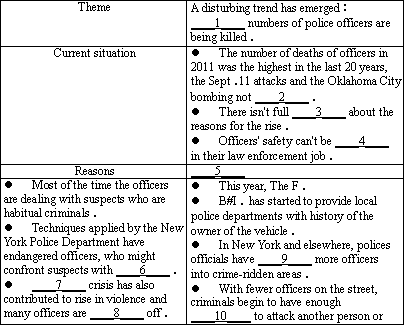
题目列表(包括答案和解析)
请认真阅读下列短文,并根据所读内容在文章后表格中的空格里填入最恰当的单词。
(注意:每空格1个单词)
WASHINGTON-According to statistics compiled by the Federal Bureau of Investigation, 72 officers were killed by criminals in 2011, increased markedly in recently years.
The 2011 deaths were the first time that more officers were killed by suspects than car accidents.The number was the highest in nearly two decades, excluding those who died in the Sept.11 attacks in 2001 and the Oklahoma City bombing in 1995.
While the F.B.I.and other law enforcement(执行)officials cannot fully explain the reasons for the rise in officer homicides, they are clear about the terrible consequences.
“In this law enforcement job, when you pin this badge on and go out on calls, when you leave home, you can't guarantee that you will come back,” said Sheriff Ray Foster of Buchanan County, Va.
After a series of killings in early 2011, Attorney General Eric H.Holder Jr.asked federal authorities to work with local police departments to try to come up with solutions to the problem.
The F.B.I., which has tracked officer deaths since 1937, paid for a study conducted by John Jay College that found that in many cases the officers were trying to arrest or stop a suspect who had previously been arrested for a violent crime.
That prompted the F.B.I.to change what information it will provide to local police departments, the officials said.Starting this year, when police officers stop a car and call its license plate into the F.B.I.'s database, they will be told whether the owner of the vehicle has a violent history.Through the first three months of this year, the number of police fatalities has dropped, though it is unclear why.
Some law enforcement officials believe that techniques pioneered by the New York Police Department over the past two decades and adopted by other departments may have put officers at greater risk by encouraging them to conduct more street stops and to seek out and confront(对抗)suspects who seem likely to be armed.In New York and elsewhere, police officials moved more officers into crime-ridden areas.
Some argue that the rise in violence is linked to the tough economy.With less money, police departments, after years of staffing increases, have been forced to make cutbacks(削减).
The police chief in Camden, N.J., J.Scott Thomson, whose force of 400 was cut by nearly half last year because of financing issues, said that having fewer officers on the street “makes it that much more difficult to create an environment in which criminals do not feel as encouraged to attack another person, let alone a law enforcement officer.”
“Every stop can be potentially fatal, so we are trying to make sure the officers are ready and prepared to face deadly force every single day they go out.” Ms.Klimt said.

I have a friend named John Roberts who owns a horse ranch (牧马场)in San Ysidro. The last time I was there he shared a story with me. “It is a story about a young man who was the son of an itinerant horse trainer. When he was a senior,he was asked to write a paper about what he wanted to be and do when he grew up.”
That night he wrote a seven-page paper describing his goal of someday owning a horse ranch. He wrote about his dream in great detail and he even drew a diagram of a 200-acre ranch, showing the location of all the buildings,the stables and the track.
“The next day he handed it in to his teacher. Two days later he received his paper back. On the front page was a large red F with a note that read, ‘See me after class.’”
“The boy went to see the teacher after class and asked, ‘Why did I receive an F?’”
“The teacher said, ‘This is an unrealistic dream for a young boy like you. You have no money. You come from an itinerant family. You have no resources. Owning a horse ranch requires a lot of money. You have to buy the land. You have to pay for the original breeding stock and later you’ll have to pay large stud fees. There‘s no way you could ever do it.’ Then the teacher added, ‘If you will rewrite this paper with a more realistic goal, I will reconsider your grade.’”
“The boy went home and asked his father what he should do. His father said, ‘Look, son, you have to make up your own mind on this. However, I think it is a very important decision for you.’”
“Finally,after sitting with it for a week, the boy turned in the same paper, making no changes at all. He stated, ‘You can keep the F and I’ll keep my dream.‘”
John continued, “I tell you this story because you are sitting in the middle of my 200-acre horse ranch. I still have that school paper framed over the fireplace.” He added, “If I had changed my paper at that time, maybe we would not have the chance to be here talking about the dreams .”
1.What was the boy’s goal described in his seven-page paper? (No more than 6 words)
2.Why did the teacher give him a F”? (No more than 14 words)
3.How did John’s father respond to his son’s puzzlement? (No more than10 words)
4.What can we learn from the article? (No more than 8 words.)
| |||||||||||||||||||||||||||||||||||||||||||||||||||||||||||
| |||||||||||||||||||||||||||||||||||||||||||||||||||||||||||
| |||||||||||||||||||||||||||||||||||||||||||||||||||||||||||||||||||||||||||||||||||||||||||||||||||||||||||||||||||||||||||||||||||||||||||||||||||||||||||||||||||||||||||||||||||||||||||||||||||||||||||||||||||||||||||||||||||||||||||||||||||||||||||||||||||||||||||||||||||||||||||
湖北省互联网违法和不良信息举报平台 | 网上有害信息举报专区 | 电信诈骗举报专区 | 涉历史虚无主义有害信息举报专区 | 涉企侵权举报专区
违法和不良信息举报电话:027-86699610 举报邮箱:58377363@163.com